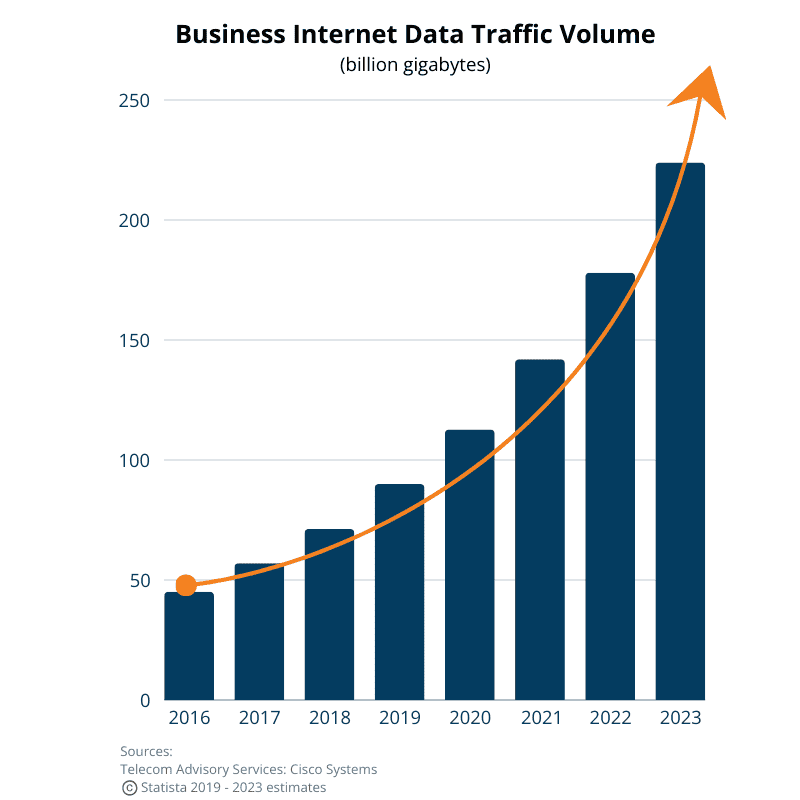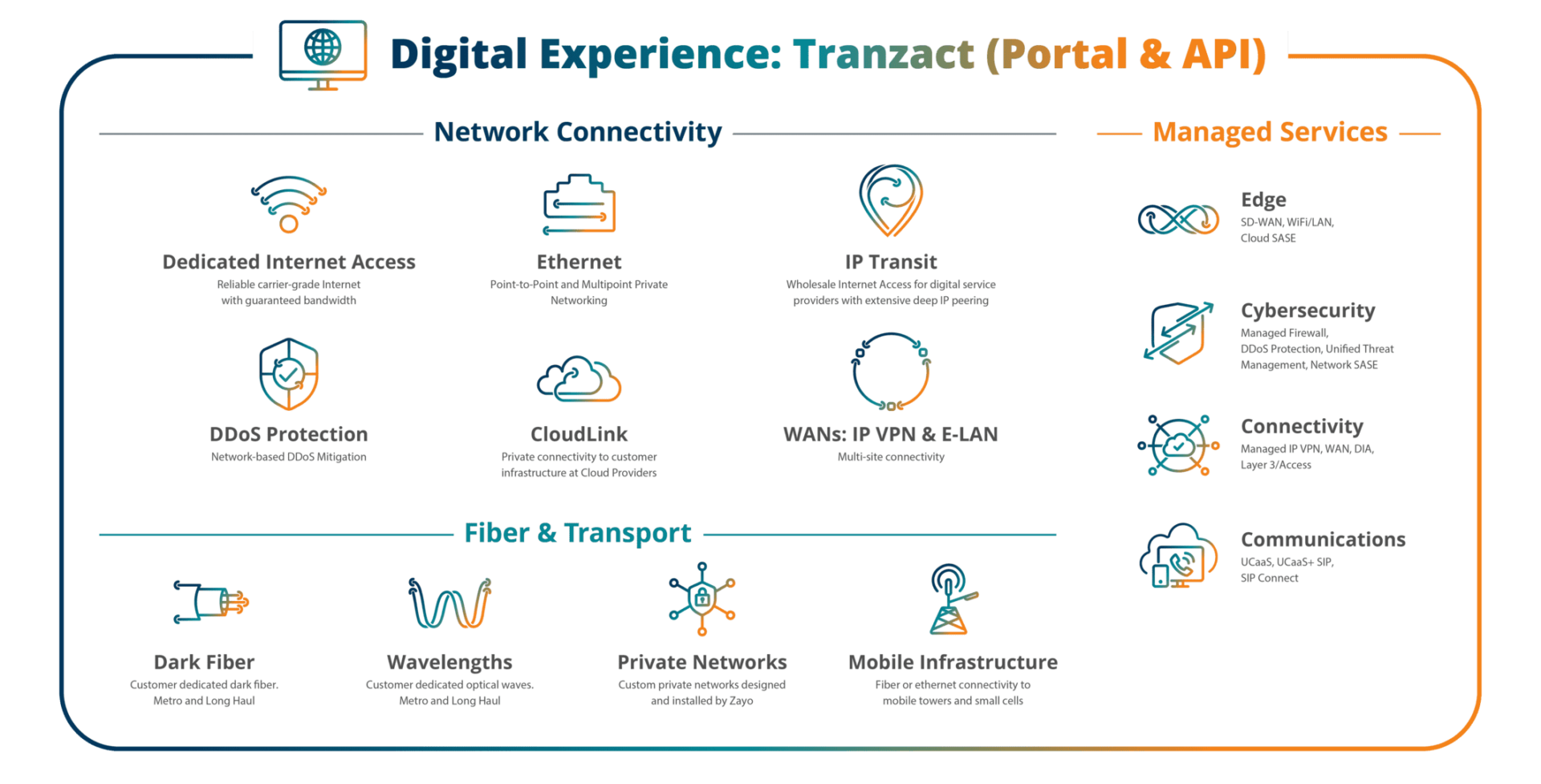While other fibre infrastructure companies are scaling back and divesting, Zayo is taking a different approach.
By Chaz Kramer, Vice President, Product, Fibre & Transport Networks
Our University of Denver NCAA national ice hockey champs might be the reason, but in Zayo’s Denver headquarters, we hear this advice so often it has become our mantra:
Don’t skate to where the puck is now. Skate to where it’s going.
To do this well, we need to see into the future, and here’s what we’re seeing:
- First, big bandwidth that’s only getting bigger
- Second, a geographic shift in where bandwidth is supplied
- Finally, using new services to make bandwidth consumable
The drivers of each of these shifts are the drivers of Zayo’s expansion efforts. Let’s talk about them.
1. A continued voracious appetite for bandwidth
If ever there was an “up-and-to-the-right” graph, this is it:

This hunger is driven by a number of factors:
The Cloud
When applications and data processing move from your organization’s basement to the Cloud, there’s a sudden need for transport – getting those applications and data back to the devices that use them.
Real-time Everything
Especially video. Well beyond Zoom calls, think virtual appointments and remote surgery. Think massive online multiplayer gaming. Think VR immersion in 3-D entertainment, and in mental health. Virtual shopping. Millions of live, always-on security cameras.
Machine Intelligence
Soon, our customers won’t be people – they’ll be machines. Our customers’ switches and routers will understand when bandwidth is running low, will shop the market through API interfaces, and will order supplemental capacity – all without human intervention. When humans split the scene, digital transactions get fast.
Which brings us to: how much bandwidth? We don’t expect this hunger for bandwidth to ever be sated, so we need to supply as much bandwidth as today’s optronics technology allows. Zayo, the builder of bandwidth, must always be ready.
2. Geographic shifts – where to next?
This is changing as well. Today, over 30% of the bandwidth running on Zayo’s global fibre network connects just 150 buildings – the largest data centres and traffic aggregation points in North America and Europe. While we’ll continue to fortify these locations and the connections between them with more and more bandwidth, we can’t ignore what’s coming:
The Re-Industrialization of North America
In the Americas, economic growth is getting a shot in the arm, and public funding for innovation in manufacturing is shifting focus from places like China to places like Mexico.
- NIST awards millions of dollars to strengthen U.S. innovation and productivity
- BEAD provides billions to expand high-speed Internet access
- SIF in Canada promotes manufacturing excellence
- The Inflation Reduction Act provide massive incentives for clean energy
- IIJA and the CHIPS Act each provide incentives for manufacturing construction
- USMCA, the updated NAFTA, promotes free markets across North America
We desperately want to avoid a repeat of distant supply chains collapsing again, and these few examples show us that the American governments are planning for a future without such pain.
New fulfillment centers will take advantage of the power of AI, and AI needs power, so they’ll be located not in traditional manufacturing hubs, but near areas with affordable and ample power . Zayo’s long haul network already runs along and through many of these rural areas, so we’ll need to build on-ramps to our long haul network. Additionally, the coming years will expand our network into Mexico.
From City Centers to the Edge
Companies like Zayo connect the locations where data is created to locations where it’s processed. Both of these are changing, and the need for real-time experiences means that we need to bring data processing closer to the source of data creation (increasingly our homes and mobile devices), lowering latency and improving the experience.
While we expand our long haul network across continents with an eye toward newer remote data centres, we cannot lose sight of metro connectivity. Zayo directly connects data centres (over 1,500 of them), and enterprise sites (now over 50,000 in North America and Europe), and will continue to as these sites move closer and closer to the edge.
Zayo’s network is integral in the web of wireless connections as well. Your wireless service provider’s network is mostly wired, and companies like Zayo provide the fibre that connects MSO towers and small cells. Wireless encompasses so much, from EV charging stations that also provide uploading capabilities for mapping data, to providing the high-capacity, low-latency connectivity for the demands of 5G networks everywhere.
Zayo does not provide fibre to homes, but we make sure that our partnerships with companies that do are strong, and that their traffic aggregation points are directly connected by Zayo.
Meeting in the Middle
Despite the bandwidth consumption presented earlier, 7.2 million U.S. homes (1 in 5) still have no Internet access. Much of the government money allocated to re-industrialize North America will also serve to finally close this Internet access gap. Specifically, NTIA’s broadband rural infrastructure programme expands “middle mile” Internet. Zayo is taking the lead. Zayo recently won an NTIA grant of $93 million to build out the middle mile in an effort to connect underserved communities.
The middle mile is the bridge between the last mile (which connects end-users to the local exchange or access point) and the long haul networks that carry data across vast distances. It enables the efficient and high-speed transfer of data traffic from local aggregation points to regional or national network centers, ensuring connectivity between various service providers and facilitating the exchange of data on a larger scale.
By defining and focusing on the middle mile and architecting it intelligently (so it becomes as affordable to carriers as our metro market infrastructure), Zayo will address gaps in broadband infrastructure, improve network resiliency, and enhance connectivity for underserved communities by strengthening this crucial link in the overall broadband ecosystem.
“I just gotta be me!”
An important calculation of where bandwidth will be needed is simply where it isn’t today. In the metro, in the middle, and along the long haul network, carriers’ easiest paths to laying new fibre (an expensive and laborious undertaking) is doing so along established rights of way. The result? Multiple carriers’ fibre infrastructure runs along the same route, sometimes within the very same conduit. Risky stuff.
Zayo’s expansion also provides protection from these crowded routes by building differently-routed long haul, middle mile, and metro fiber. We call these our “unique routes.” With the right protection mechanisms in place, unique routes ensure that an alternate data path is available when a primary path is cut.
3. And How?
Zayo designed, built, owns, operates, and expands its global fibre network based on where the puck is going. Owning the network means that we have ultimate control over the services we provide over that network.
Offering big bandwidth, in the right places, are two key elements to our expansion strategy. A third is: with which services? Because not every company can take a raw, unlit fibre strand and make it work for them, Zayo’s expansion includes a broad service portfolio, making bandwidth consumable to those who purchase it.
- Dark Fibre – the physical glass in the ground – handing transport control to the customer
- Private Networks – dark or lit fibre + the equipment – dedicated to the customer
- Wavelengths – 10 Gbps to 400 Gbps, massive lit and ultra-low-latency capacity
- Ethernet Private Lines – an electrical version of a wave with lower bandwidth
- CloudLink – dedicated Cloud access, bypassing the public Internet
- WANs – full mesh private networking for lots of locations
- IP – Tier 1 Internet services
And, a new lineup of managed services, bringing the power of Zayo’s massive fibre network into play at the edge. It’s not enough to build the fibre to the edge, because our fibre cannot reach every enterprise. Our edge services can.
This latest expansion to the edge includes SD-WAN, SASE, Voice, and our Unified Communications services, integrated from acquired companies QOS Networks, Education Networks of America (ENA), and Allstream.
Here’s the entire line-up:

In summary – we expand because our customers demand it of us, and because it will provide a strong network foundation for tomorrow’s reality.
